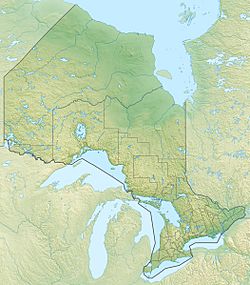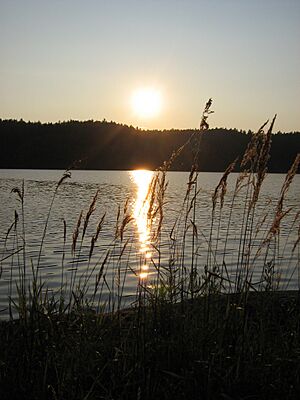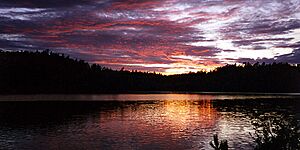Rabbit Lake (Temagami) facts for kids
Quick facts for kids Rabbit Lake |
|
|---|---|

Hub of Rabbit Lake in the spring
|
|
| Location | Temagami, Ontario |
| Coordinates | 47°00′04″N 79°38′19″W / 47.001°N 79.6385°W |
| Part of | Ottawa River drainage basin |
| Primary inflows | Cassells Lake, Rabbit Creek |
| Primary outflows | Matabitchuan River |
| Basin countries | Canada |
| Surface elevation | 288 m (945 ft) |
Rabbit Lake is a beautiful lake located in the Temagami area of Northeastern Ontario, Canada. Its name in the Ojibway language is "Waw-bos Nah-mat-ta-bee." This lake is the biggest and most southern in a group of lakes that includes Cassels Lake, Snake Island Lake, and Obashkong Lake.
Long ago, Rabbit Lake was a very important path for trade among the Indigenous peoples. There's even a story about a brief conflict between the Temagami natives and the Iroquois. The story says that some Iroquois were camping on an island. One night, some Temagami people quietly went ashore and damaged the bottoms of their canoes. The next morning, as the Iroquois tried to leave, their canoes began to sink, making it hard for them to escape.
Contents
Exploring Rabbit Lake's Natural Beauty
The forests around Rabbit Lake have been used for logging since the early 1900s. You can still see where the trees haven't fully grown back, especially north of Rabbit Point.
The Rabbit Lake West Conservation Reserve
On the western side of the lake, near Rabbit Point, there's a special area called the Rabbit Lake West Conservation Reserve. This 491-hectare (about 1,213-acre) area has never been touched by logging. It's one of the most untouched places of its kind in Ontario. The old trees here are very similar to the original Boreal forest that once covered Temagami.
Fish and Wildlife in Rabbit Lake
Rabbit Lake is an oligotrophic lake, which means its waters are very clear and have low levels of nutrients. Even though the number of fish has gone down over the years, the lake is still home to many different kinds of fish. You can find pike, walleye, trout, whitefish, perch, and bass here.
Rabbit Lake on the Big Screen
Did you know Hollywood once visited Rabbit Lake? Parts of the movie "Captains of the Clouds" starring James Cagney were filmed here. The filming took place at Matabitchuan Lodge, a wilderness lodge located in the north-east bay of the lake. You can even see props from the movie on display at the lodge! This film was also the first Hollywood movie ever to be filmed entirely in Canada.
Understanding Rabbit Lake's Geography
The land around Rabbit Lake is part of the Canadian Shield. This is a huge area of very old rocks that formed after the Earth's crust cooled down. The hills in the Temagami area are what's left of North America's oldest mountain range. These mountains were once as tall as the Himalayas!
How the Mountains Were Formed
These ancient mountains were created over millions of years by powerful forces. One way was through folding, where huge pressure caused the Earth's surface to bend and buckle. Other processes, like volcanic activity (when hot rock erupts from the Earth) and geologic faulting (when the Earth's crust cracks), also helped shape these mountains. Over time, these enormous mountains slowly wore down to become the landscape we see in Temagami today.
Modern Challenges for Rabbit Lake
While Rabbit Lake is mostly a peaceful place with some cottages, the surrounding forest is still being logged. There's also a growing concern about mining in the area. This is because a special type of volcanic rock called kimberlite has been found. Kimberlite is important because it can sometimes contain diamonds.
This area is part of the Temagami Greenstone Belt. This belt is made of very old Archean volcanic rocks. Protecting these unique natural areas is important for the future of Rabbit Lake.
Images for kids







